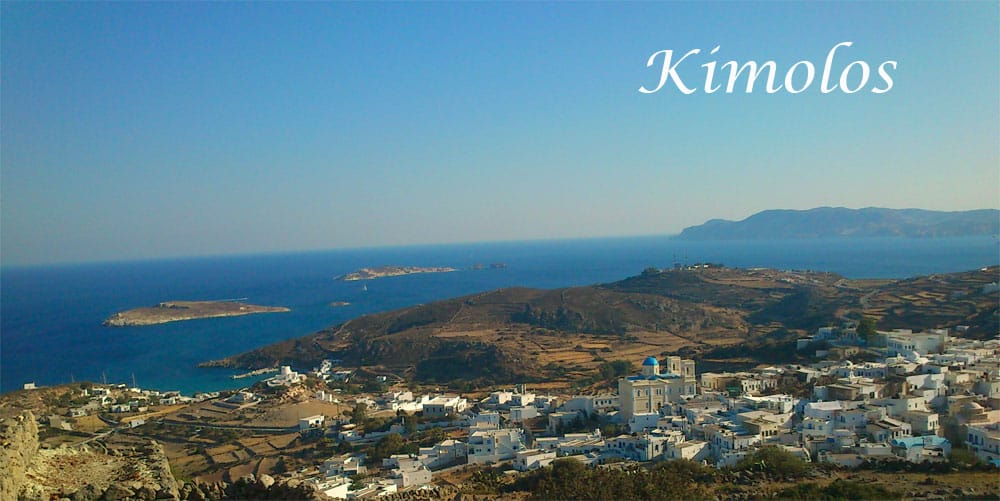Information about the island of Kimolos
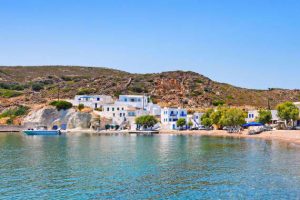
Kimolos is a place of unique beauty, where at every step nature surprises with its creations. Kimolos, the beautiful Cycladic island, despite its small area, has hidden treasures and some very interesting attractions.
The ancient city of Kimolos in the area of Ellinkines, the sunken cave at Vromolimnos, the volcanic rocks , the Castle one of the most important residential centers of the Cyclades, Skiadi a unique monument of nature at world level, the remains from the processing of the poria in the small port of Agios Nikolas and the old ferro-manganese loading ladder in Agios Minas.
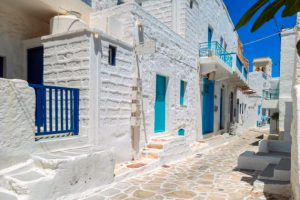
Kimolos is a small, picturesque island that, due to its special morphology, its coastline forms many small coves that host magical beaches and a rich seabed that enchants.
Windless coves, beautiful formations of white rocks with volcanic rocks, enchanting sea caves with amazing turquoise waters, make up the profile of the island.
Many beaches are still isolated and remote, some easily accessible and others difficult to reach by footpath or by sea, some with sand or pebbles, rocks for diving, but all worth it.
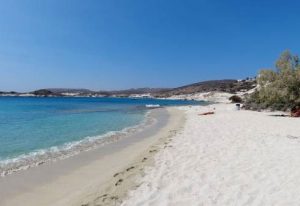
The cuisine of Kimolos is a part of the island’s history, culture, and daily life, which ingeniously utilizes the available materials of an arid place.
Far from the globalization of taste, traditional Cremation delicacies suggest an awakening of the senses and will pleasantly surprise anyone who dares to explore them with their simplicity, imagination and “advanced” combinations.
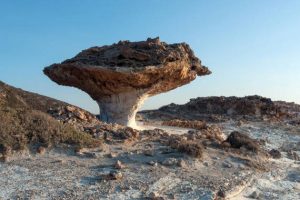
Hiking trails can lead you to every corner of this virgin island, some of them in Skiadi, a rare monument, not only for Greece but worldwide, impressive for its size and form, which is included in the Atlas of Geological Monuments of the Aegean.
Chorio is the main settlement of Kimolos, dominated by the strong Cycladic colors, with the simple traditional architecture. The Kimoliates love their island and will help you in any way they can to get to know their place.
General Information about Kimolos
Kimolos belongs to the Cyclades group and is located in the southwest Aegean, between Sifnos and Milos. It is located near Milos, from which it is separated by the Amoni Strait. Administratively, it belongs to the Regional Unit of Milos of the South Aegean Region and constitutes the single Municipality of Kimolos.
The capital of the island is the village of Kimolos, which hosts the majority of the island’s inhabitants. Smaller settlements that are inhabited mainly in the summer, while in the winter they have few inhabitants, are Psathi (port), Goupa, Kara, Prasa, Aliki, Bonatsa and Deka. The port and main port is Psathi, at the south-eastern end of the island and it is about 0.8 kilometers from Chorio. It has approximately 600 permanent residents, most of whom currently live in the Village.
History
The name of Kimolos has remained the same since ancient times and comes, according to mythology, from the first settler Kimolos, husband of Sidi, daughter of Taurus, who in turn gave her name to the white rock, known from the chalkboards.
In ancient times it was known by the name Echinussa because of the sea urchins that abounded and abound on its rocky shores. It was also known as Ofidousa, because of the chalk echidna (viper) that even today abounds on the island.
From the Middle Ages until the Greek Revolution of 1821 it was called Arzendiera, apparently because of the colour of its rocks, but also because of the silver mines that existed on the island.
Another legent says that Kimolos means moving Milos. The theory that says that Kimolos was cut off from the neighboring island after a terrifying geophysical activity immemorial years ago is also evident here.
The main settlement of Kimolos
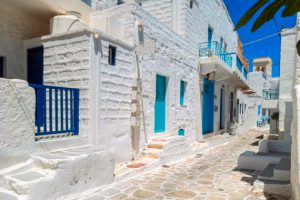
The Village is built around the Castle, the foundation of which is placed with doubts around 1200 AD. The Pano and Kato Porta lead the steps of the visitors on a walk through the centuries.
Coats of arms, coats of arms and pilasters appear in the ruined buildings. The Castle was built with the local ironstone and has a fortified architecture: its shape was square and the houses were built in two rows, with the outer one also forming a wall.
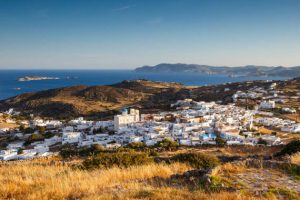
Coats of arms, coats of arms and pilasters appear in the ruined buildings.
The Castle was built with the local ironstone and has a fortified architecture: its shape was square and the houses were built in two rows, with the outer one also forming a wall. Inside the Castle there is the island’s oldest church, built in 1592.
In any case, you will end up on the central cobbled street, the Agora. If you want to see the sea as well, then you will go to Psathi, that is, to the port, which remains quiet and picturesque. Lostromos, one of the oldest café-bars on the island, open from the morning, has a lively atmosphere and a wonderful host: Cuervo, the labrador-mascot of the port who will always welcome you like an old good friend.
What to see
The Caldera of Kimolos
What few people know about Kimolos is that it also has a caldera. When hearing the word caldera, everyone’s mind justifiably goes to one of the most impressive islands in the Mediterranean, Santorini! On the north side of the island you will find “Geronikolas”, as the locals call this particular part of the coastline. These are thin layers of grayish-white volcanic rocks that blend harmoniously with the Aegean Sea. The landscape really captivates anyone who visits it, especially if it is done by boat!
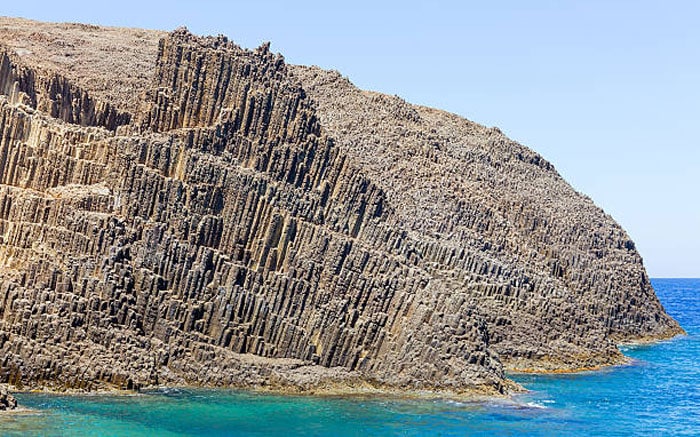
Pelekiti Cave
If you have a boat at your disposal, do not miss the opportunity to visit the Pelekiti cave in Kakopotamos. When this cave was created and for what purpose remain unknown, but it is in excellent condition and its construction shows characteristic symmetry. There you will refresh yourself in the warm thermal water that springs up on Agioklima beach or you can explore the cave in Kavos of Gerakia and dive into its wonderful turquoise waters.
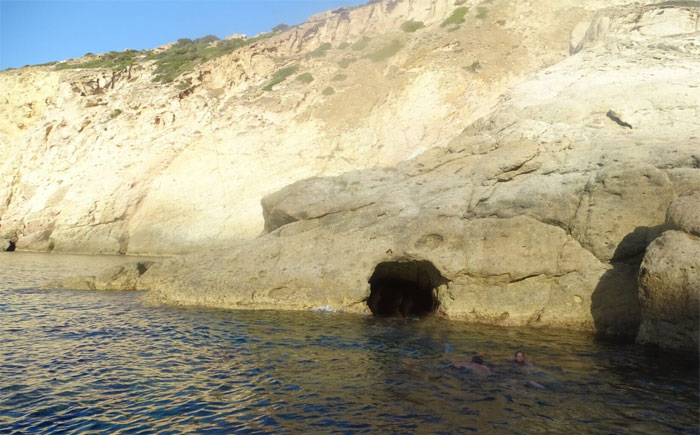
Mavrospilia
In the southwestern part of Kimolos you will make a date with history. The Hellenic area is known for the necropolis and the ruins of some ancient tombs. It is thought to have been part of a city, which existed during the Mycenaean period and was destroyed due to a great earthquake! In fact, according to the locals, there are even more ruins in the sea between Kimolos and Milos, which will come to light at some point.
A little further you will find the sandy beach of Mavrospilia, in which there is actually a sea cave in the rocks. Also, you will admire an interesting group of rocks in the sea in front of the beach, which uniquely seal the sunset.
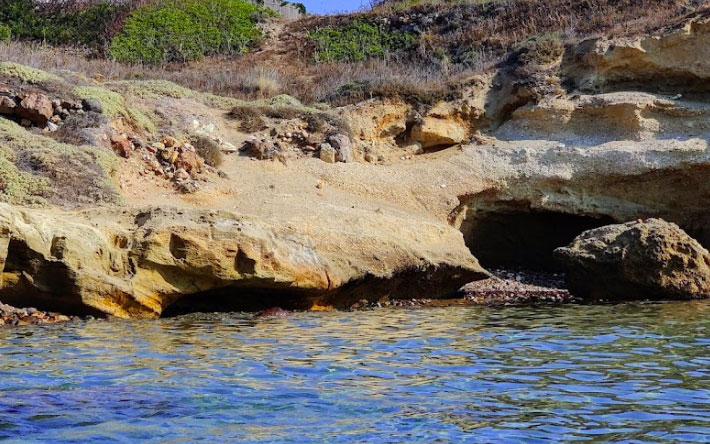
Agios Nicholas
Agios Nikolas is a picturesque fishing village in the eastern part of the island, about four kilometers from the Village. Its name came from the small church of Agios Nikolaos that exists there, while it has a small sandy beach ideal for cool dips. In the settlement you will also find the impressive waste from the processing of the porias and the sheltered port of Agios Minas with the old ferro-manganese loading ladder.
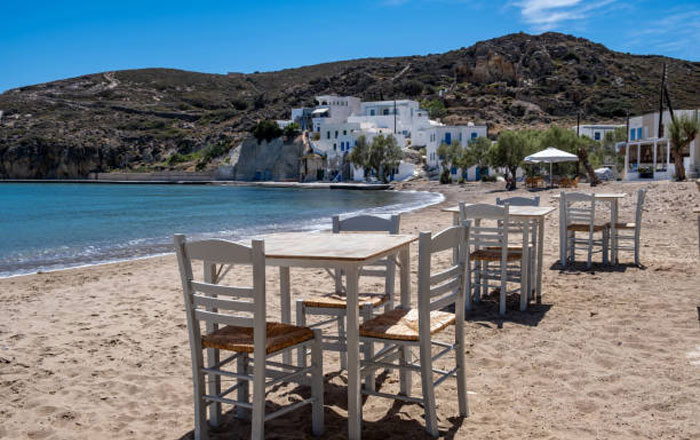
Visit Skiadi
Visit in an afternoon, the geological formation of Kimolos, Skiadi, the “mushroom” said to be made up of 70 different types of rock and has been shaped by the deposition of soft rocks at its base. Let the golden light bring out even more the beauty of the half-hour hike, and continue for another hour to Mavrospilia for sunset.
The route takes advantage of old cobblestones and, in addition to the beautiful views of the hills and the sea, it meets dry stone groves, olive groves and an amazing stone farmhouse with a threshing floor.
You will reach the beginning of the path by a dirt road, which starts from the fishing shelter of Agios Minas or from the village, for the dirt road ask the locals for directions, as there are no signs.
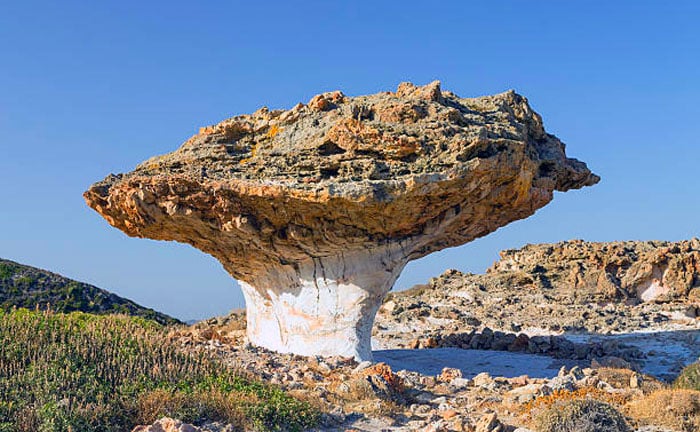
Goupa
The most photographed spot on the island, however, is definitely Goupa, which is divided into individual small coves. The first of these is called Rema and is a beautiful pebble beach. The second is called Elefantas and the third Karras! Karras is not an ordinary beach, since it does not have sand but all-white rocks reminiscent of a lunar landscape.
Don’t expect beach bars, umbrellas and sunbeds there, while shade is an endangered species. So when you visit, make sure you have the right snacks and lots of sunscreen in advance. Of course, the crystal clear turquoise waters of Karras are sure to delight you! Finally, in Karras you will also find the famous “wires” (caves carved into the rocks), which are decorated with colorful doors and served as storage areas, mainly for boats.
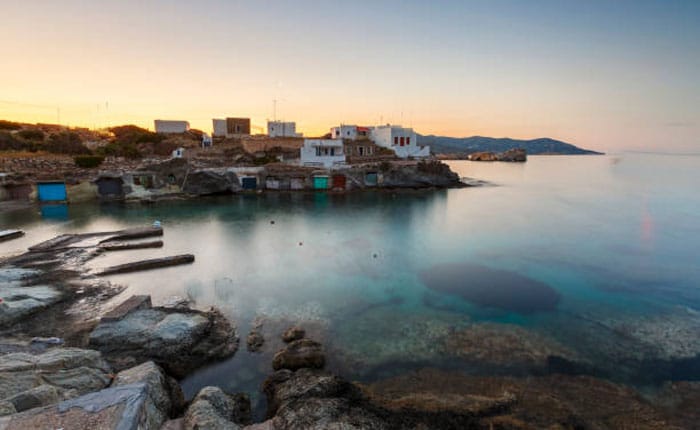
Visit the museums
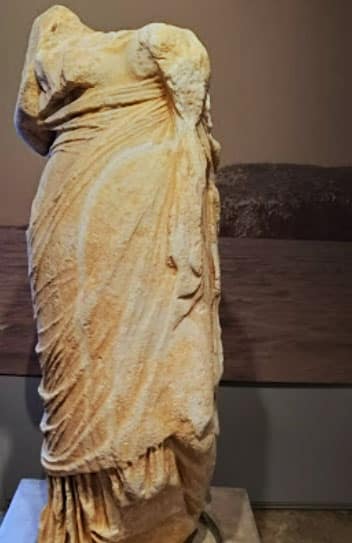
It is housed in one of the oldest buildings of the settlement and has been operating since 2006. There you will admire interactive exhibits that present the history of the island and various finds on the island of Kimolos from the late Neolithic period until today! Entrance costs 3e.
The other museum of the island that is worth visiting is the Folklore Museum. It is housed in a two-story, traditional building of the Castle of Kimolos located at “Pano Porta”.
On the ground floor, the exhibits are presented in sections in the large hall, while in the smaller one there are beds and all the tools related to weaving.
Finally, in the attic, the original layout of the house, which was the ancestral home of the Museum’s founder, doctor Mr. Manolis Christoulakis, has been restored, with his mother’s original furniture and offerings from Kimoliats, while the corridor has been arranged in a nautical corner. Entrance also costs 3e.
Beaches
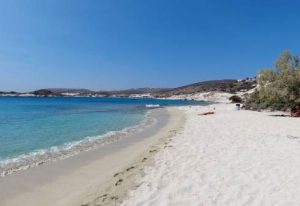
Relatively close to the port you will find three more wonderful beaches, which are similar to each other and definitely worth swimming in their crystal clear waters. I am of course referring to Aliki, Bonatsa and Kalamitsi.
First, on the beach of Aliki, the “lake” is home to many species of birds, while nature will surprise you at every step. On the other hand, next to the cape of Ag. Georgiou in Kalamitsi, you can see the figure carved by the hand of an anonymous artist on the rock. Finally, give Bonatsa a chance too, which looks like it’s straight out of a postcard.
Where to eat

It is also worth trying the tyrenia (a type of open cheese pie with a sheet of bread dough), the elenia (bread stuffed with olives) and nuts. Finally, in Kimolos you will find excellent honey, myzithra , cucumbers, capers and tomato paste, made from local tomatoes
The food in Kimolos is generally quite good, but stingy in its prices, without preparing the customers by a relevant sign-menu. The Kalamitsi tavern, on the beach of the same name, is the most honest on the island, with their own or local raw materials, as already mentioned. Equally delicious and at a reasonable price-quality ratio, you can eat in Sardis, in Aliki, on the cool terrace with the thatched roof.
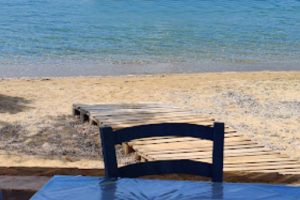
The Kali Kardia cafe in Chorio has a nice position in the alley and a large menu, from which we singled out the moussaka and the meatballs.
Kyma in Psathi is considered the gourmet seafood restaurant of the island with ceviche, carpaccio, lobster pasta, etc., in an excellent location, on the beach. At Prasonisi, in Prassa, you will try seafood dishes.Inside the Village there is also the good grill Old Market
How to get to Kimolos
By Air
Most international travelers will first arrive in Athens, which is the capital of Greece and has the largest international airport in the country, Athens International Airport (Eleftherios Venizelos).
From Athens, you can catch a domestic flight to Milos. There are daily flights from Athens to Milos, especially during the summer months. The flight takes approximately 30 minutes.
By Ferry
It’s also possible to take a ferry directly from the port of Piraeuss to Kimolos, but these are less frequent than the Milos-Kimolos route. The direct ferry from Piraeus to Kimolos can take several hours. Make sure to check ferry schedules and availability before planning your trip.
Ferry to Kimolos from Milos
Once you’re in Milos, you can take a ferry from the port of Pollonia in Milos to Kimolos. The ferry ride usually takes around 20-30 minutes, and ferries are frequent, especially during peak tourist season. Kimolos is also connected by ferry to other islands in the Cyclades, so if you are island hopping, you can easily include Kimolos in your itinerary.
